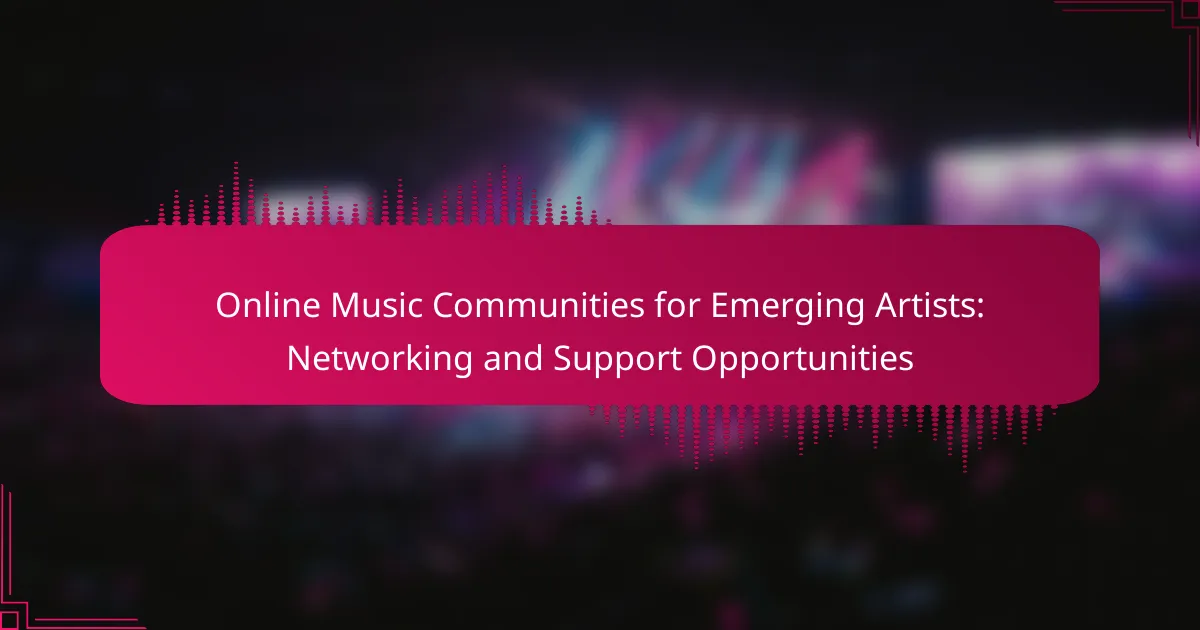Independent artists face unique challenges in music production, often working with limited budgets and resources. Essential DIY music production tools like digital audio workstations, audio interfaces, and microphones are crucial for creating high-quality music. This article reviews key tools, offers recommendations based on genre and budget, and highlights features that enhance creativity and efficiency. Additionally, it addresses strategies for overcoming production challenges and maximizing the potential of available tools.
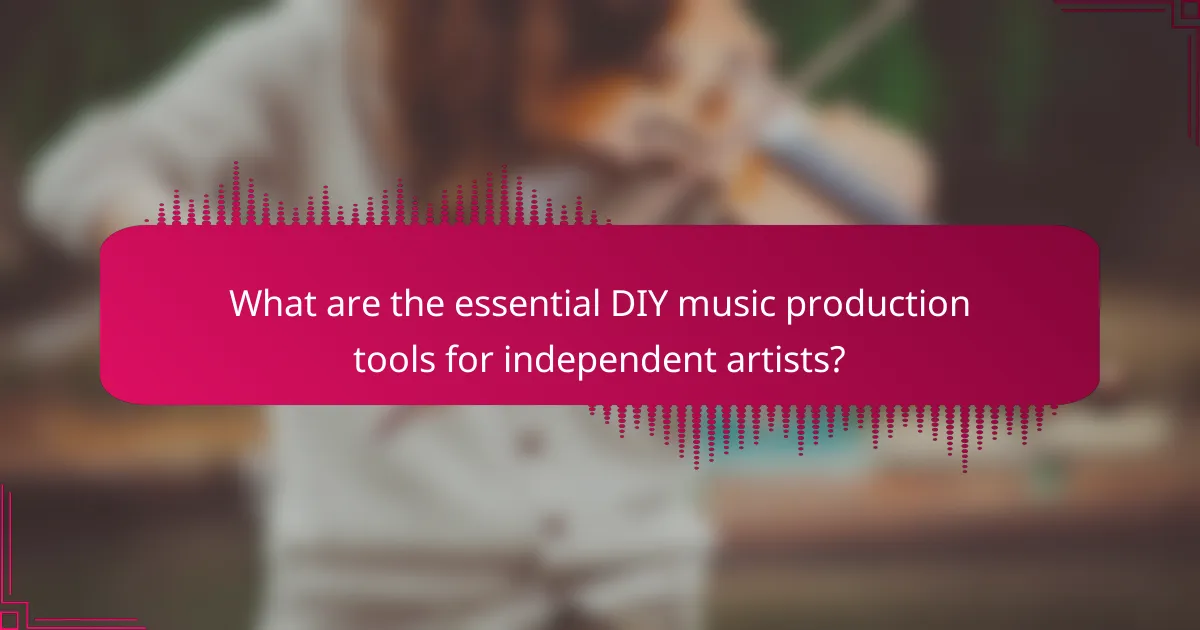
What are the essential DIY music production tools for independent artists?
Independent artists need essential DIY music production tools to create high-quality music. Key tools include digital audio workstations (DAWs), audio interfaces, microphones, studio monitors, and MIDI controllers.
1. Digital Audio Workstations (DAWs): Software like Ableton Live and FL Studio allows for recording, editing, and mixing music.
2. Audio Interfaces: Devices such as Focusrite Scarlett enhance sound quality and connect instruments to computers.
3. Microphones: Quality microphones like the Shure SM58 capture vocals and instruments effectively.
4. Studio Monitors: Speakers like KRK Rokit provide accurate sound reproduction for mixing.
5. MIDI Controllers: Tools like Akai MPK Mini facilitate music creation through virtual instruments.
These tools empower independent artists to produce professional-sounding music from their home studios.
How do software options differ for music production?
Software options for music production vary in features, usability, and pricing. Key differences include the level of complexity, the types of instruments and effects available, and the platforms they support. Some software caters to beginners with user-friendly interfaces, while others target professionals with advanced capabilities. For instance, DAWs like Ableton Live offer extensive MIDI support and performance features, whereas GarageBand provides a straightforward approach for novice users. Additionally, subscription models versus one-time purchases can influence artist choices, affecting long-term costs.
Which hardware tools are must-haves for home studios?
Essential hardware tools for home studios include a digital audio interface, studio monitors, a microphone, headphones, and a MIDI controller. These tools enhance sound quality and facilitate music production.
Digital audio interfaces convert audio signals to digital format, ensuring high-quality recordings. Studio monitors provide accurate sound reproduction, essential for mixing. A good microphone captures vocals and instruments effectively. Headphones are crucial for detailed listening, while MIDI controllers enable easy music composition and arrangement.
Investing in these tools creates a solid foundation for any home studio, allowing independent artists to produce professional-quality music.
What role do digital audio workstations play in music production?
Digital audio workstations (DAWs) are essential for music production, enabling artists to compose, record, and edit music efficiently. DAWs provide a user-friendly interface for mixing tracks and applying effects, which enhances creativity and productivity.
Independent artists benefit from features like virtual instruments and plugins, allowing diverse sound creation. The accessibility of DAWs, often available at various price points, makes them suitable for different budgets. Popular options include Ableton Live, FL Studio, and Logic Pro, each offering unique attributes that cater to specific production styles.
As a result, DAWs play a critical role in empowering independent artists to produce high-quality music from home.
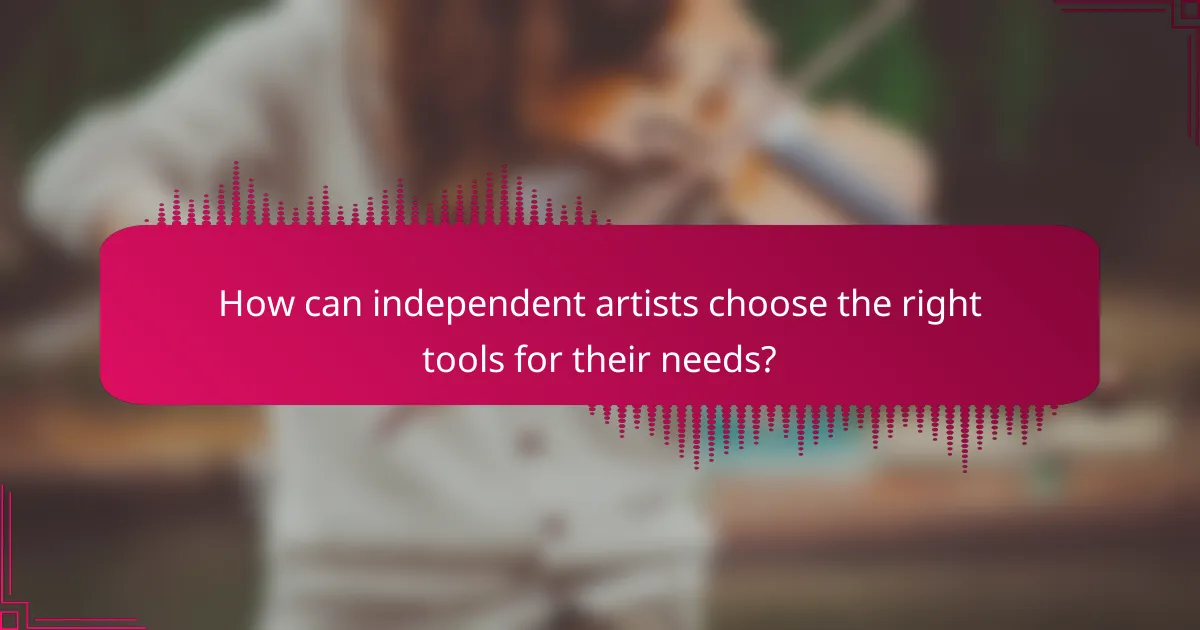
How can independent artists choose the right tools for their needs?
Independent artists can choose the right tools by assessing their specific needs and budget. Key considerations include software for music production, hardware for recording, and plugins for sound enhancement.
1. Identify your music genre to select compatible tools.
2. Determine your budget to narrow down options.
3. Research user reviews and comparisons for insights.
4. Test free trials when available to evaluate usability.
5. Prioritize tools that offer scalability as your skills grow.
What factors should be considered when selecting music production software?
When selecting music production software, consider user interface, features, compatibility, and price. A user-friendly interface enhances creativity. Essential features include virtual instruments and effects. Ensure compatibility with your operating system and hardware. Finally, evaluate pricing models, including one-time purchases versus subscriptions.
How does budget impact tool selection for DIY music production?
Budget significantly influences tool selection for DIY music production by determining the quality and range of equipment available. A limited budget may lead artists to prioritize essential tools like digital audio workstations and basic microphones, while a larger budget allows for advanced software and high-end hardware.
Independent artists can find quality options across various price ranges. For example, free or low-cost DAWs like Audacity and GarageBand serve beginners well, while professional-grade software like Ableton Live or Pro Tools offers advanced features at higher price points.
Investing in versatile tools can maximize budget efficiency. For instance, a multi-functional audio interface can serve as a microphone preamp, MIDI controller, and headphone amplifier, consolidating multiple needs into one device.
Ultimately, understanding the budget’s impact on tool selection helps artists make informed decisions that align with their production goals and creative vision.
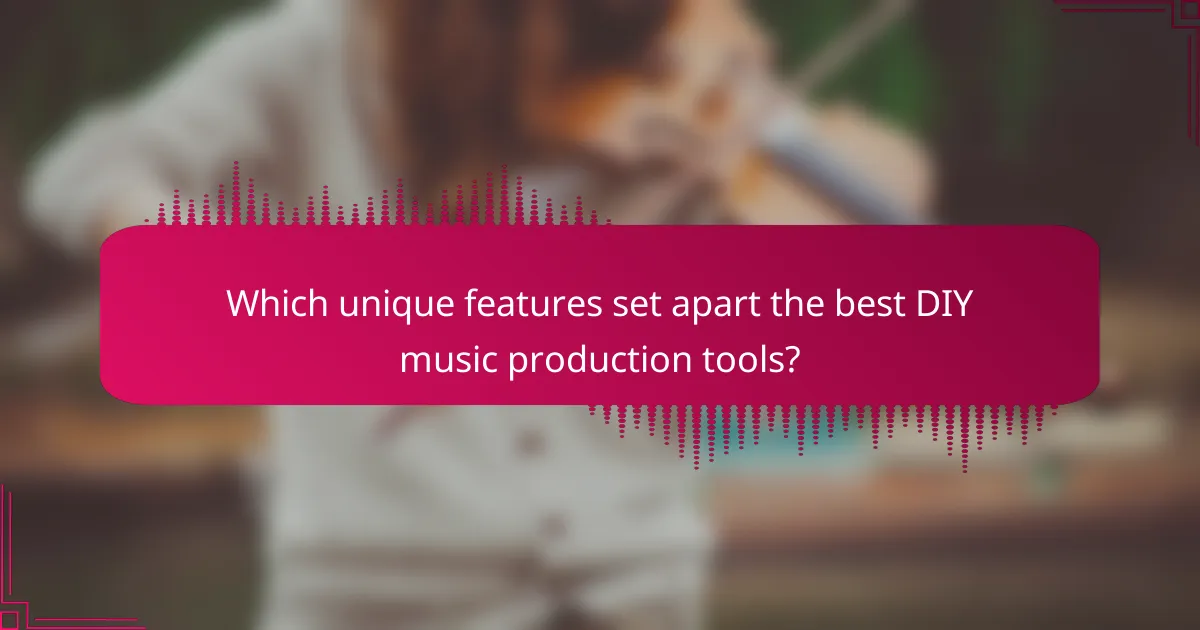
Which unique features set apart the best DIY music production tools?
The best DIY music production tools stand out due to their unique features like intuitive interfaces, versatile sound libraries, and advanced editing capabilities. These attributes enhance creativity and streamline the production process for independent artists. For example, tools that support real-time collaboration allow artists to work seamlessly with others, regardless of location. Additionally, some tools offer unique sound design options, enabling users to create distinctive audio textures that set their music apart. Finally, affordability without compromising quality is a rare attribute that many independent artists seek in DIY music production tools.
What innovative technologies are emerging in music production tools?
Innovative technologies in music production tools include AI-driven software, cloud-based collaboration platforms, and advanced virtual instruments. These tools enhance creativity and efficiency for independent artists. AI music composition software, like Amper Music, allows for quick creation of unique tracks. Cloud platforms, such as Splice, enable real-time collaboration among artists. Advanced virtual instruments, like Native Instruments’ Kontakt, provide expansive sound libraries and customizable features. These technologies empower artists to produce high-quality music independently.
How do user interfaces affect the music production experience?
User interfaces significantly enhance the music production experience by improving accessibility and creativity. Intuitive designs streamline workflows, allowing artists to focus on their sound rather than technical obstacles. Features like drag-and-drop functionality and customizable layouts cater to individual preferences, fostering a more personalized creative process. Additionally, responsive interfaces provide real-time feedback, which is crucial for making timely adjustments during production. Overall, effective user interfaces empower independent artists to maximize their potential with DIY music production tools.
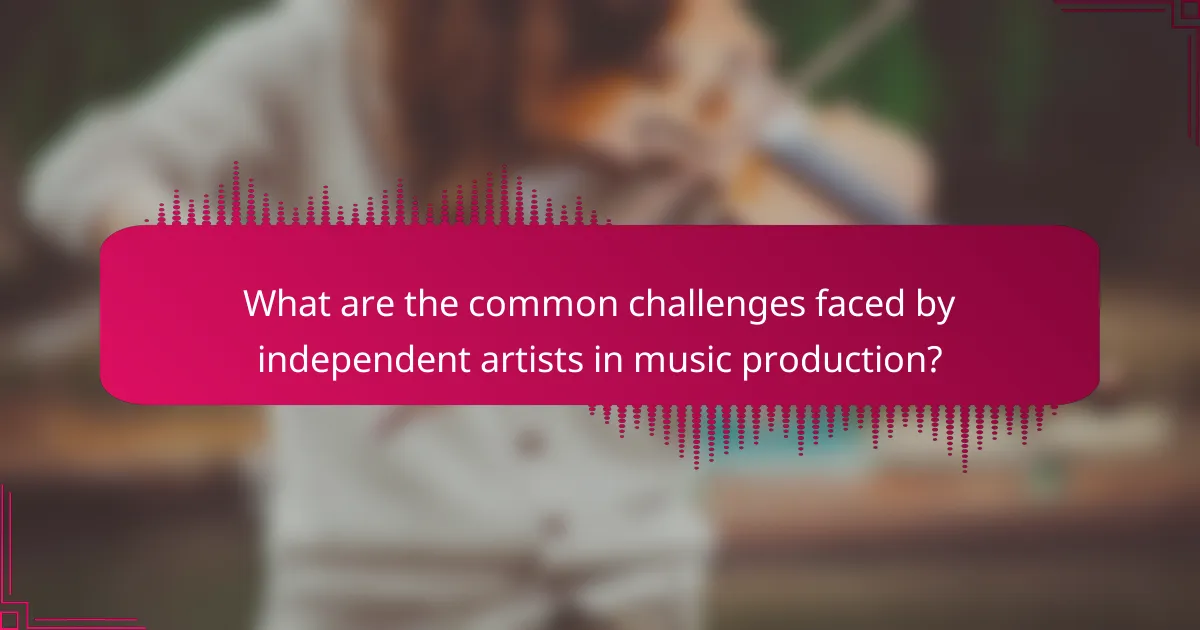
What are the common challenges faced by independent artists in music production?
Independent artists face challenges in music production, including limited budgets, lack of access to professional studios, and insufficient marketing knowledge. These obstacles hinder their ability to create, distribute, and promote their music effectively.
Budget constraints often force artists to rely on DIY tools for production, which can impact sound quality. Access to professional-grade equipment and software is essential but often unaffordable. Additionally, many independent artists struggle with self-promotion and understanding digital marketing strategies, limiting their reach and audience engagement.
Networking opportunities are also scarce, making collaboration difficult. Independent artists must navigate a competitive landscape with fewer resources than established musicians. This situation requires creativity and resourcefulness in overcoming production challenges while maintaining artistic integrity.
To succeed, artists should invest time in learning about available DIY music production tools and strategies. Utilizing online platforms for distribution and promotion can enhance visibility and help build a loyal fan base.
How can artists overcome technical difficulties with their tools?
Artists can overcome technical difficulties with their tools by leveraging online resources, tutorials, and community support. Utilizing platforms like YouTube and forums allows for real-time problem-solving. Experimenting with various software and hardware can also lead to discovering unique solutions. Regular practice enhances familiarity with tools, reducing technical barriers over time. Seeking feedback from peers fosters collaborative learning and skill improvement.
What are the limitations of using DIY music production tools?
DIY music production tools can limit creativity, quality, and collaboration. Independent artists may struggle with steep learning curves and lack of professional sound. Additionally, resources may be limited, impacting production value. Finally, reliance on software can hinder spontaneity in music creation.
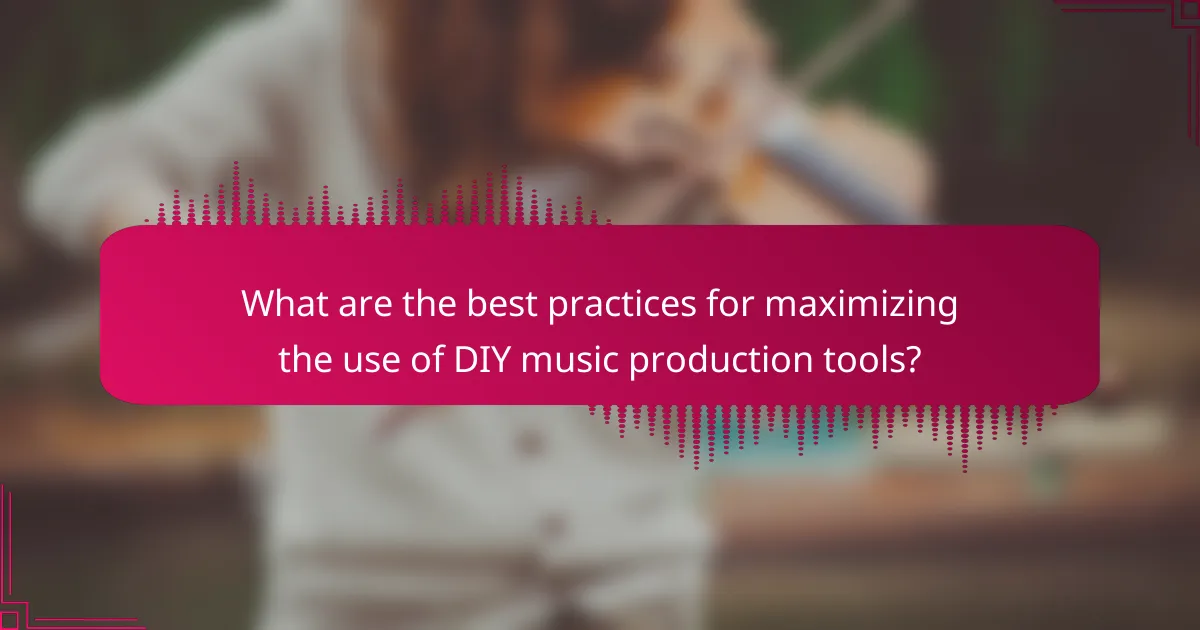
What are the best practices for maximizing the use of DIY music production tools?
To maximize the use of DIY music production tools, focus on optimizing workflow, leveraging online resources, and experimenting with different techniques. Prioritize tools that enhance creativity and efficiency.
1. Organize your workspace to minimize distractions and streamline access to tools.
2. Utilize tutorials and forums to learn advanced techniques and troubleshoot issues.
3. Experiment with various software and hardware combinations to find your unique sound.
4. Regularly update your tools to access new features and improvements.
5. Collaborate with other artists to gain fresh perspectives and ideas.
How can independent artists optimize their workflow with available tools?
Independent artists can optimize their workflow by utilizing various DIY music production tools that enhance efficiency and creativity. Essential tools include digital audio workstations (DAWs), audio interfaces, and virtual instruments.
1. DAWs like Ableton Live or FL Studio streamline recording and editing processes.
2. Audio interfaces improve sound quality and connectivity with instruments.
3. Virtual instruments offer diverse sounds without physical instruments.
4. Collaboration tools like Splice facilitate remote teamwork and sharing.
5. Sample libraries provide ready-to-use sounds, saving time in production.
These tools collectively enhance the creative process, allowing artists to produce high-quality music more efficiently.
What common mistakes should be avoided in DIY music production?
Common mistakes to avoid in DIY music production include neglecting proper acoustics, overusing effects, skipping the mixing stage, and ignoring feedback. These errors can diminish sound quality and hinder artistic expression. Prioritize a balanced mix, utilize effects sparingly, and create a conducive recording environment for optimal results.
Which expert tips can enhance the music production process?
To enhance the music production process, independent artists should utilize high-quality DIY tools. Focus on essential software and hardware that improve workflow and sound quality.
1. Invest in a reliable digital audio workstation (DAW) for streamlined music creation.
2. Use MIDI controllers to facilitate intuitive music composition.
3. Incorporate audio interfaces for superior sound input and output.
4. Explore plug-ins for enhancing audio effects and mixing capabilities.
5. Leverage online collaboration tools to connect with other musicians remotely.


